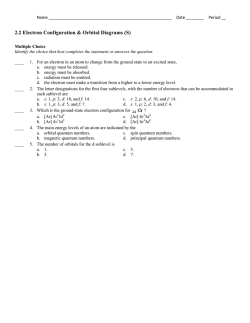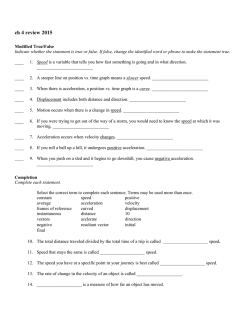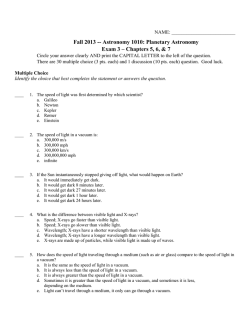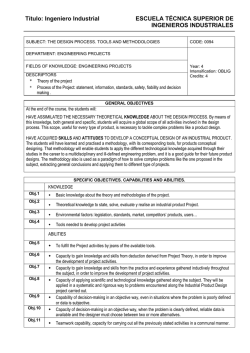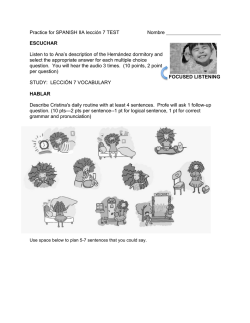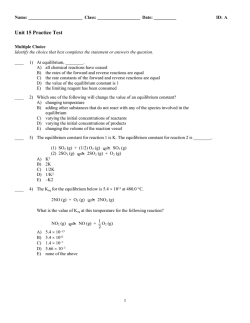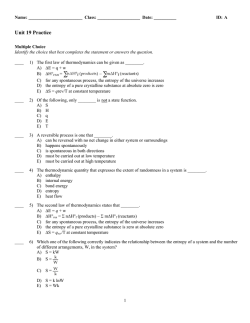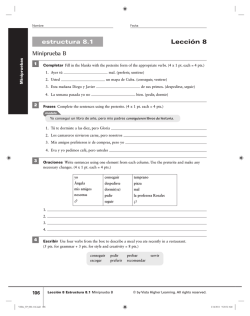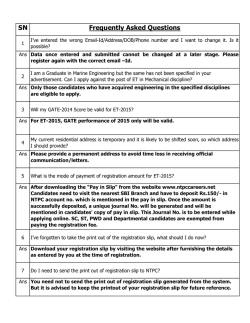
Practice-Unit 4 - Biloxi Public Schools
PSYCHOLOGY SECTION I Time--___ Minutes ___ Questions, Unit 4 Practice/Quiz Unit 4 Practice Directions: Each of the questions or incomplete statements below is followed by five suggested answers or completions. Select the one that is best in each case and then fill in the corresponding circle on the answer sheet. 1. Sensation is to ________ as perception is to 4. Although Manuel was sitting right next to his ________. a. encoding; detection b. detection; interpretation c. interpretation; organization d. organization; accommodation e. threshold; transduction parents, he smelled a skunk minutes before they did. Apparently, Manuel has a lower ________ for skunk odor than his parents have. a. accommodation level b. absolute threshold c. tolerance level d. olfactory saturation level e. adaptation level 2. While a man provided directions to a construction worker, two experimenters rudely interrupted by passing between them carrying a door. The student's failure to notice that the construction worker was replaced by a different person during this interruption illustrates a. blind spot. b. gate-control theory. c. bottom-up processing. d. change blindness. e. top-down processing. 5. During a hearing test, many sounds were presented at such a low level of intensity that Mr. Antall could hardly detect them. These sounds were below Mr. Antall's a. subliminal threshold. b. absolute threshold. c. adaptation threshold. d. difference threshold. e. auditory threshold. 6. Diminished sensitivity to an unchanging stimulus is known as a. sensory accommodation. b. blindsight. c. sensory adaptation. d. transduction. e. equilibrium. 3. The local fire department sounds the 12 o'clock whistle. The process by which your ears convert the sound waves from the siren into neural impulses is an example of a. sensory adaptation. b. accommodation. c. parallel processing. d. transduction. e. sensory interaction. 1 Name: ________________________ ID: A 7. Stereotypes are mental conceptions that can 11. Supercell clusters are a. located in the spinal cord and conduct most strongly influence the way we interpret the behaviors of individuals belonging to specific racial or ethnic groups. A stereotype is most similar to a. a feature detector. b. perceptual adaptation. c. a perceptual set. d. a difference threshold. e. gate-control theory. b. c. d. 8. The study of phenomena such as clairvoyance e. and telepathy is called a. parapsychology. b. Gestalt psychology. c. human factors psychology. d. ESP. e. perceptual adaptation. pain signals to the somatosensory cortex in the parietal lobe. connected to hair cells located along the basilar membrane in the inner ear. photoreceptor cells, located in the retina, that combine to send information to the visual cortex. teams of cells that fire in response to complex patterns, such as the human face. combined messages from the semicircular canals and vestibular sacs in the inner ear that monitor head position and movement. 12. Opponent-process cells have been located in the a. b. c. d. e. 9. Intensity is to brightness as wavelength is to a. accommodation. b. frequency. c. amplitude. d. hue. e. disparity. thalamus. cochlea. spinal cord. visual cortex. semicircular canals. 13. The principles of continuity and closure best illustrate the importance of a. binocular cues. b. perceptual adaptation. c. Weber's law. d. perceptual constancy. e. top-down processing. 10. The adjustable opening in the center of the eye is the a. fovea. b. iris. c. cornea. d. pupil. e. blind spot. 14. Imagine your friend walking toward you in the hall at school. As your friend gets closer, the image cast on your retina a. gets smaller. b. gets larger. c. gets darker. d. stays exactly the same. e. appears higher in your field of vision. 2 Name: ________________________ ID: A 15. The perception that Bugs Bunny is hopping 19. Damage to the basilar membrane is most likely across a movie screen best illustrates a. the Müller-Lyer illusion. b. retinal disparity. c. the Ponzo illusion. d. stroboscopic movement. e. opponent-process. to result in a. loss of movement. b. accommodation. c. conduction hearing loss. d. loss of the sense of balance. e. nerve deafness. 16. Lightness constancy refers to the fact that a. the frequency of light waves has a fixed b. c. d. e. 20. Cones and rods are to vision as ________ are to audition. a. eardrums b. cochleas c. oval windows d. hair cells e. semicircular canals relationship to the brightness of the light. objects are perceived to have consistent lightness even if the amount of light they reflect changes. light waves reflected by an object remain constant despite changes in illumination levels. the perceived whiteness of an object has a constant relation to its lightness. one of the depth cues involves perceiving dimmer objects as being farther away. 21. The discovery that high-frequency sounds trigger large vibrations near the beginning of the basilar membrane supports the ________ theory. a. gate-control b. frequency c. Young-Helmholtz d. opponent-process e. place 17. Color constancy refers to the fact that a. light waves reflected by an object remain b. c. d. e. constant despite changes in lighting. objects are perceived to be the same color even if the light they reflect changes. the perceived color of an object has a constant relation to its brightness. the frequency of light waves is directly proportional to the light's wavelength. colors remain the same hue even when the tint changes under our difference threshold. 22. A time lag between left and right auditory stimulation is important for accurately a. locating sounds. b. detecting pitch. c. recognizing rhythms. d. judging amplitude. e. determining frequency. 23. Researchers have identified receptors for which 18. Who emphasized that perceptual understanding of the following skin sensations? a. pain b. cold c. warmth d. pressure e. hot comes from inborn ways of organizing sensory experience? a. Immanuel Kant b. Aristotle c. John Locke d. Sigmund Freud e. B. F. Skinner 3 Name: ________________________ ID: A 24. According to the gate-control theory, a back 27. Kinesthesis refers to the a. quivering eye movements that enable the massage would most likely reduce your physical aches and pains by causing a. release of pain-killing endorphins in your muscles. b. activation of nerve fibers in your spinal cord. c. the release of adrenaline into your bloodstream. d. deactivation of the pain receptors on the surface of your skin. e. the cochlea to transduce impulses sent to the spinal cord. b. c. d. e. retina to detect continuous stimulation. process by which stimulus energies are changed into neural signals. diminished sensitivity to an unchanging stimulus. system for sensing the position and movement of individual body parts. process of organizing and interpreting sensory information. 28. The influence of bodily sensations, gestures, and other states on cognitive preferences and judgments is known as a. synesthesia. b. kinesthesia. c. perceptual set. d. parallel processing. e. embodied cognition. 25. The role of central nervous system activity for the experience of pain is best highlighted by a. prosopagnosia. b. frequency theory. c. phantom limb sensations. d. the opponent-process theory. e. perceptual adaptation. 29. As Maria and her little brother looked up at the 26. Which of the following best explains why clouds, he exclaimed, “That one looks like a giant dinosaur!” Maria thought it looked more like a giant duck. Which of the following concepts best explains their different interpretations of the same ambiguous stimuli? a. shape constancy b. context effects c. perceptual set d. selective attention e. difference thresholds children are more likely to resist eating strong-tasting foods? a. Sensory interaction makes certain foods more unpleasant to taste. b. Young children have more taste receptors, so their sensitivity to taste is greater. c. Children are more strongly influenced by the McGurk effect than adults are. d. Receptor cells on a child's tongue are replaced more slowly than those of adults. e. Only children are deterred from eating foods with aversive tastes. 30. The feature detectors identified by Hubel and Weisel respond to specific aspects of ________ stimulation. a. vestibular b. visual c. auditory d. olfactory e. kinesthetic 4 ID: A Unit 4 Practice Answer Section MULTIPLE CHOICE 1. ANS: TOP: 2. ANS: TOP: 3. ANS: TOP: 4. ANS: TOP: 5. ANS: TOP: 6. ANS: TOP: 7. ANS: TOP: 8. ANS: TOP: 9. ANS: TOP: 10. ANS: TOP: 11. ANS: TOP: 12. ANS: TOP: 13. ANS: TOP: 14. ANS: TOP: 15. ANS: TOP: 16. ANS: TOP: 17. ANS: TOP: 18. ANS: TOP: 19. ANS: TOP: 20. ANS: TOP: 21. ANS: TOP: B PTS: 1 DIF: Difficult OBJ: Unit IV | 16-1 Basic Principles of Sensation and perception SKL: Conceptual D PTS: 1 DIF: Easy OBJ: Unit IV | 16-2 Selective inattention SKL: Factual/Definitional D PTS: 1 DIF: Medium OBJ: Unit IV | 16-3 Transduction SKL: Conceptual/Application B PTS: 1 DIF: Medium OBJ: Unit IV | 16-4 Absolute thresholds SKL: Conceptual/Application B PTS: 1 DIF: Easy OBJ: Unit IV | 16-4 Absolute thresholds SKL: Conceptual/Application C PTS: 1 DIF: Easy OBJ: Unit IV | 16-5 Sensory adaptation SKL: Factual/Definitional C PTS: 1 DIF: Medium OBJ: Unit IV | 17-1 Perceptual set SKL: Conceptual A PTS: 1 DIF: Medium OBJ: Unit IV | 17-2 ESP - Perception without sensation SKL: Factual/Definitional D PTS: 1 DIF: Difficult OBJ: Unit IV | 18-1 The stimulus input: light energy SKL: Conceptual D PTS: 1 DIF: Easy OBJ: Unit IV | 18-1 The eye SKL: Factual/Definitional D PTS: 1 DIF: Medium OBJ: Unit IV | 18-2 Feature detection SKL: Factual/Definitional A PTS: 1 DIF: Medium OBJ: Unit IV | 18-3 Color vision SKL: Factual/Definitional E PTS: 1 DIF: Difficult OBJ: Unit IV | 19-1 Visual organization SKL: Conceptual B PTS: 1 DIF: Easy OBJ: Unit IV | 19-2 Motion perception SKL: Conceptual/Application D PTS: 1 DIF: Medium OBJ: Unit IV | 19-2 Motion perception SKL: Conceptual/Application B PTS: 1 DIF: Medium OBJ: Unit IV | 19-3 Color and brightness constancy SKL: Factual/Definitional B PTS: 1 DIF: Medium OBJ: Unit IV | 19-3 Color and brightness constancy SKL: Factual/Definitional A PTS: 1 DIF: Medium OBJ: Unit IV | 19-4 Experience and Visual Perception SKL: Factual/Definitional E PTS: 1 DIF: Medium OBJ: Unit IV | 20-1 The ear SKL: Factual/Definitional D PTS: 1 DIF: Difficult OBJ: Unit IV | 20-1 The ear SKL: Conceptual E PTS: 1 DIF: Easy OBJ: Unit IV | 20-2 Perceiving pitch SKL: Factual/Definitional 1 ID: A 22. ANS: TOP: 23. ANS: TOP: 24. ANS: TOP: 25. ANS: TOP: 26. ANS: TOP: 27. ANS: TOP: 28. ANS: TOP: 29. ANS: TOP: 30. ANS: TOP: A PTS: 1 DIF: Easy OBJ: Unit IV | 20-3 Locating sounds SKL: Factual/Definitional D PTS: 1 DIF: Easy OBJ: Unit IV | 21-1 Touch SKL: Factual/Definitional B PTS: 1 DIF: Medium OBJ: Unit IV | 21-2 Pain SKL: Conceptual/Application C PTS: 1 DIF: Medium OBJ: Unit IV | 21-2 Pain SKL: Factual/Definitional B PTS: 1 DIF: Medium OBJ: Unit IV | 21-3 Taste SKL: Factual/Definitional D PTS: 1 DIF: Medium OBJ: Unit IV | 21-4 Body position and movement SKL: Factual/Definitional E PTS: 1 DIF: Easy OBJ: Unit IV | 21-5 Sensory interaction SKL: Factual/Definitional C PTS: 1 DIF: Medium OBJ: Unit IV | 17-1 Perceptual set SKL: Conceptual/Application B PTS: 1 DIF: Easy OBJ: Unit IV | 18-2 Feature detection SKL: Factual/Definitional 2
© Copyright 2026
